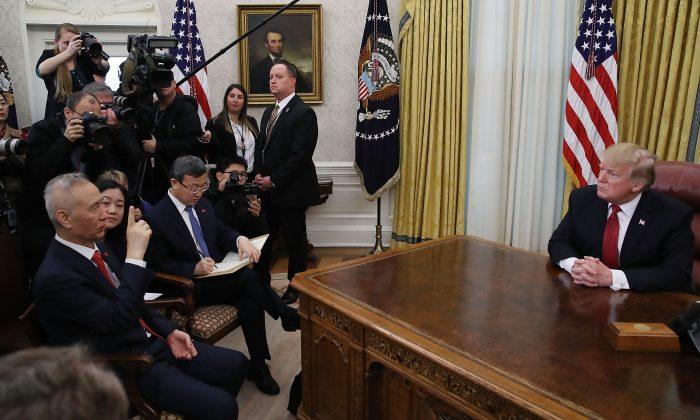WASHINGTON—The United States and China ended two days of high-level talks on Jan 31, leaving all the hopes for a deal to the next meeting between President Donald Trump and Chinese leader Xi Jinping. A wide gap remains between U.S. demands and what Beijing is prepared to offer.
“I think we’ve made tremendous progress,” Trump told reporters during his meeting with China’s Vice Premier Liu He in the Oval Office.
He said he might meet Xi “maybe once or maybe twice,” to conclude a trade deal.
“When President Xi and I meet, we want to have it [differences] down so we have certain points we can discuss—and I would say agree to—but we are not quite at that stage yet,” he said.
The U.S. and China officials met in Washington on Jan. 30-31 to try to resolve their differences and reach an agreement before the March 1 deadline. U.S. Trade Representative Robert Lighthizer led the second and the final day of the trade talks with China’s top trade negotiator Liu and his team. The high-level negotiations were followed by a closing meeting between Trump and Liu, where both sides continued to express optimism.
This was the highest-level gathering since Trump met with Xi on Dec. 1, 2018, when they declared a 90-day truce on tariffs.
At the meeting, Lighthizer said that both sides made progress but still have many unresolved issues.
He also said the talks focused on solving structural issues and enforcement of a potential agreement, suggesting that sticking points mainly center around Trump’s priorities, which include ending intellectual property (IP) theft and forced technology transfer.
A U.S. delegation headed by Lighthizer will hold another round of talks in February in Beijing, to follow up on outstanding issues.
During the meeting, the Chinese delegation presented a letter to Trump from Xi.
“Right now, China–U.S. relations are at a critically important stage,” the letter stated. “I hope our two sides will continue acting in a spirit of mutual respect and cooperation and step up consultations by meeting each other halfway in order to reach an early agreement that works in the best interest of both sides.”
Following the meeting, the White House released a concluding statement listing U.S. priorities, which include ending forced technology transfer, IP theft, tariff and non-tariff barriers, cyber theft, state subsidies, and currency manipulation, as well as opening the Chinese market to U.S. goods, services and agriculture.
“The United States is particularly focused on reaching meaningful commitments on structural issues and deficit reduction. Both parties have agreed that any resolution will be fully enforceable,” the White House statement said.
Washington signaled that it won’t back down unless China fundamentally changes its policies.
“While progress has been made, much work remains to be done,” the statement said, adding that the 90-day peace process agreed to in Argentina represented a hard deadline.
White House confirmed that if both sides fail to reach a satisfactory outcome by March 1, the United States will increase tariffs on Chinese goods.
A few hours before the meeting on Jan. 31, Trump posted a series of tweets, saying that the meetings were “going well with good intent and spirit on both sides.”
He expressed optimism about making a “comprehensive transaction” with China, but said any deal that fails to open Chinese markets to U.S. businesses would be “unacceptable.”
Trump also said Chinese officials have an incentive to strike a deal to avoid tariffs.
Economic growth in China slowed to its weakest pace in nearly three decades in the fourth quarter, and that’s putting pressure on the Chinese leader. The Shanghai composite index tumbled nearly 25 percent in 2018.
With hopes of possible progress in trade negotiations, Chinese stocks have gained 5 percent since the beginning of this year. If both sides fail to reach a deal and trade tensions resume, China’s troubles will deepen, according to experts.
According to Trump, the final accord will be made when he meets his counterpart Xi before the March deadline.
“No final deal will be made until my friend President Xi, and I, meet in the near future to discuss and agree on some of the long-standing and more difficult points,” Trump wrote on Twitter, adding that he wouldn’t leave anything unresolved on the table.





